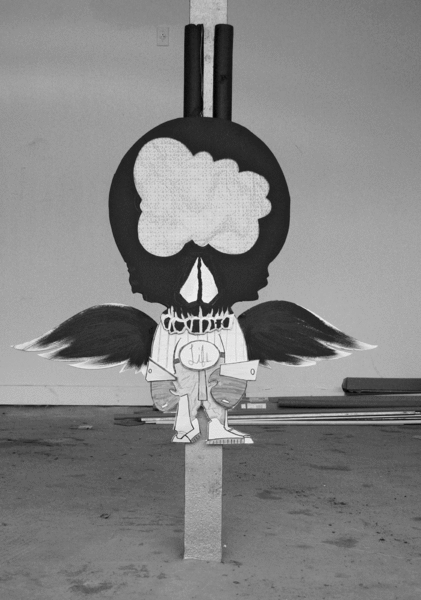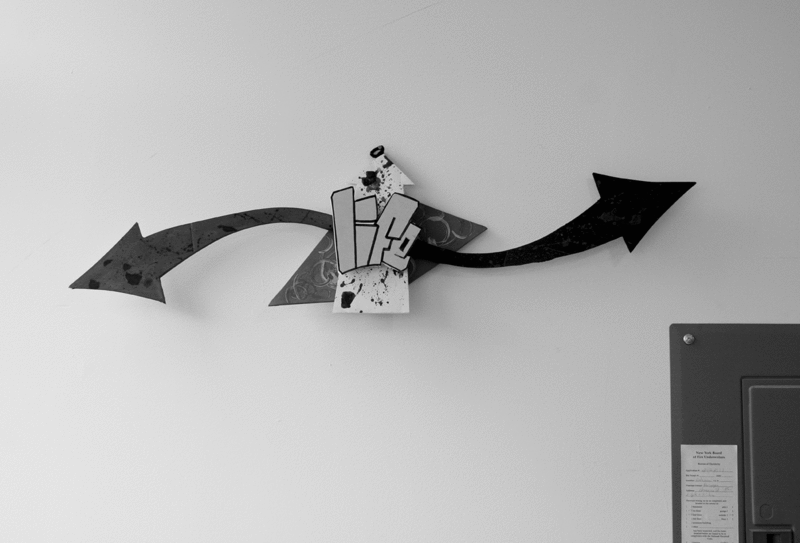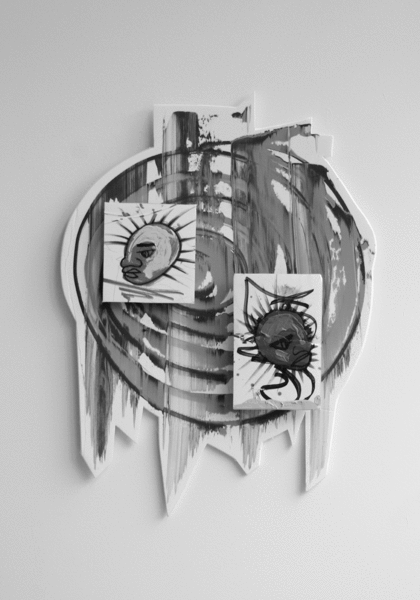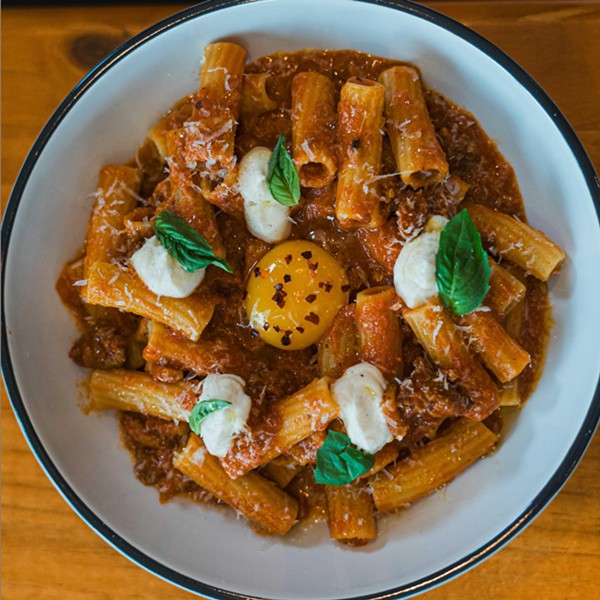It’s relatively easy to assess the work of an artist who’s been at work for years—hindsight, as they say, is 20/20. But there’s something much more exciting (and risky) in the encounter with a newly-minted artist, someone just coming into his/her own as a creative force in the universe. Ryan Sullivan is an example of the latter.
Growing up in Poughkeepsie, struggling with learning issues at school, Sullivan started as a teenage student at the Children’s Media Project, founded in 1994 by Maria Marewski “to create a teaching/learning environment where artists, educators, community activists and especially children and youth can learn to interact with the media arts both as creators and critical viewers.” He now works at CMP, located in Poughkeepsie, with the next generation of Dutchess County youth.
He was recently selected by Judy Sigunick to participate in Ellenville’s “10x10x10” public art program to create an installation in an empty storefront downtown in the village. Drawing on his background in graffiti art and graphic design, Sullivan stepped up to the challenge by transforming himself into a painter, creating a vibrant, colorful series of two and three-dimensional works that explore the tension between street art chaos and expressionist abstraction. As Sigunick said to me, “Something true happened” in the work on this installation.
His enthusiastic embrace of painting is obvious, energetic, and infectious, as I learned when I sat down to speak with him recently at CMP.
The installations of “10x10x10” are on view through October 5 in downtown Ellenville. www.childrensmediaproject.org.
RYAN SULLIVAN ON HIS WORK
Lessons out of school
Early on, they realized I had a learning disability, so I was in special ed from third grade to high school. It was a pretty rough road, but the lack I have in those areas, I make up for with art. I just don’t get the reading/writing thing so well. I’m more of a visual type of person. As I got older, I started reading up on these artists, and realized that I’m not weird, or I shouldn’t be labeled as a special education student—I’m really just a visual learner. What sucked about the school system is that they didn’t have an outlet, they didn’t have anything set up for me, so I was put in classes with some kids who were really messed up—some kids had behavioral problems, some kids had actual problems that they took medication for. It was hard for me until I got to high school, and then I realized that I need something else, something that the school can’t provide for me. Then I met Tim Sutton and Maria Marewski at the Children’s Media Project, so from ninth grade on, that’s all I did. I’ve been here since I was 15, since 1999. Their mission is to bring students up, and to employ them, and I’m an actual case of that. Now I’m an employee, which is great.
I started doing graffiti in sixth grade, trying to deal with being thrown into this big middle school. I was working mostly on paper, getting down my style. I wasn’t doing a name [with my graffiti]. I would just open the dictionary and pick a word at random, and I eventually learned how to spell words by doing it that way, but it was a longer process than I would have liked. After a while, I started watching movies about graffiti, and things that really inspired me. There’s a famous graffiti artist from Poughkeepsie named Ewok. I got a chance to meet him when I was really young, and he’s still one of my favorites, but I’ve kind of left that stuff behind to really find my own voice.
My first piece [at CMP], was an antigraffiti piece, which was pretty funny, given my background. It was a cool perspective though, to have to step out and really look from the outside in. It opened my eyes to a lot of things. After I made the piece, I understood that I could be really good, and be respected, and I don’t need to be known, I don’t need to run from the cops to do my art. I don’t get a thrill from that. I realized that doing illegal graffiti wasn’t something I really wanted to do—it’s a felony, and if you get caught three times, that’s three strikes. I can’t jeopardize my future for fame.
The birth of an artist
I’ve been doing art for a long time, but I would never consider myself as an artist. I thought that an artist was someone who sells their canvases of landscapes to millionaires, for thousands of dollars. It took the “10x10x10” show for me to think “I’m an artist.” That’s why I give Judy [Sigunick] such credit. Whenever there’s a book written about me, she’ll have a whole chapter about how she catapulted me into this world of art.
Judy was at CMP for a meeting or something, and I hadn’t painted anything at that point. She saw some of my installation work that I’ve been doing with foamcore—I call it 3DG (for “3D graffiti”). She saw those and was really interested, and wanted to know more about me what I do. She explained the “10x10x10” concept, and asked me to do a window. When I realized I had to make the stuff, I almost backed out! Then I watched the movie Basquiat, and even before the movie was done I started painting. I just grabbed some house paint that I had lying around, and I started painting and painting and painting. I didn’t stop for a few days. Then I went out and actually got a canvas—wow, once I had the canvas, it took me to another level, and I just kept on going and going. Then I started buying bigger canvases, and more expensive canvases, getting paint that wasn’t house paint. I started bringing the paintings into work and had a couple of critique sessions here, so I could get a feel for whether they needed more, or less, or whatever. People were really responding, it was great.
So right after seeing that movie, I was thinking about his story—why am I any different? He was just a young artist who had his own thing, trying to make it. It really put into perspective that I can be an artist, that I can do this.
Getting into the work
People love the chaos drawn back to some of the linear swatches, to the structure. The four little paintings up top, with the drips, they’re an experiment with yin/yang and the four elements. Things work well in threes and fours. All the bigger ones that were lined up, they were in threes. I’m all about creating series of paintings, experimenting a lot. It’s really been a big breakthrough for me—it’s like everything that goes on in the painting is meant to go on there. I’ve trained myself not to get caught up in how people are going to react to it so I don’t change things just because of how I think people are going to react. In my room the walls are splattered [with paint], because I’d start flinging it at a painting, and I turn around and it’s all over my TV. I don’t know how the splats are going to go. I want my pieces to have an atmosphere, a feeling, instead of just being paintings.
Alternative labeling
Through CMP and my mentor Tim Sutton, I realized that special education was just a label—and as long as you’re labeled, you’re going to be looked at a certain way. I eventually got out [in the high school], and I saw that there was more to the school than the one wing that they kept us on. I started branching out, and making more videos, and doing things like anti tobacco ads, getting my stuff seen. It was a good outlet for me, because I really struggled through school. Tim sat down with me, and I still have the list we made of things I had to do to graduate. It really helped, really worked.
CMP was my art school. I took one art class [in public school], and every year after that, the art teachers would constantly tell me I should take their classes, told me I should go to art school. But I couldn’t grasp the concept of art that’s made as a project. I thought it was stifling. “Okay, we’re going to make a mobile today.” I don’t mind dipping into other stuff, but I didn’t feel that they would give me the freedom that CMP was giving me.




















